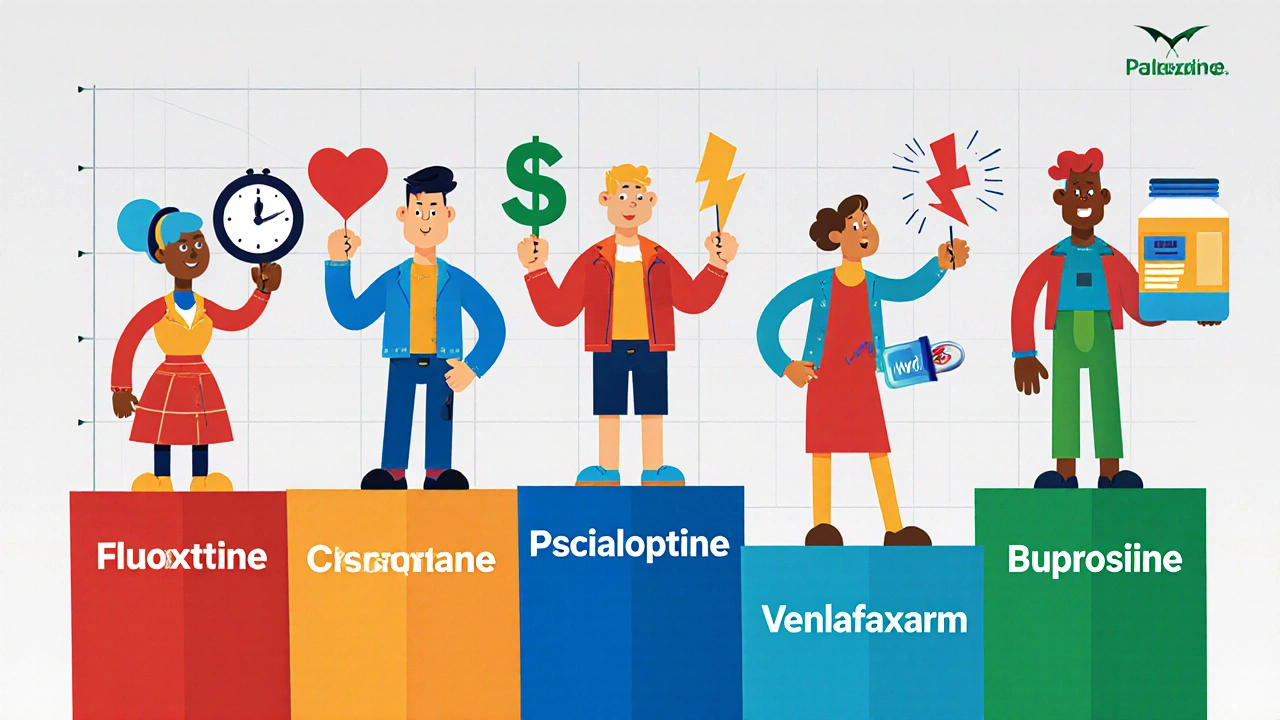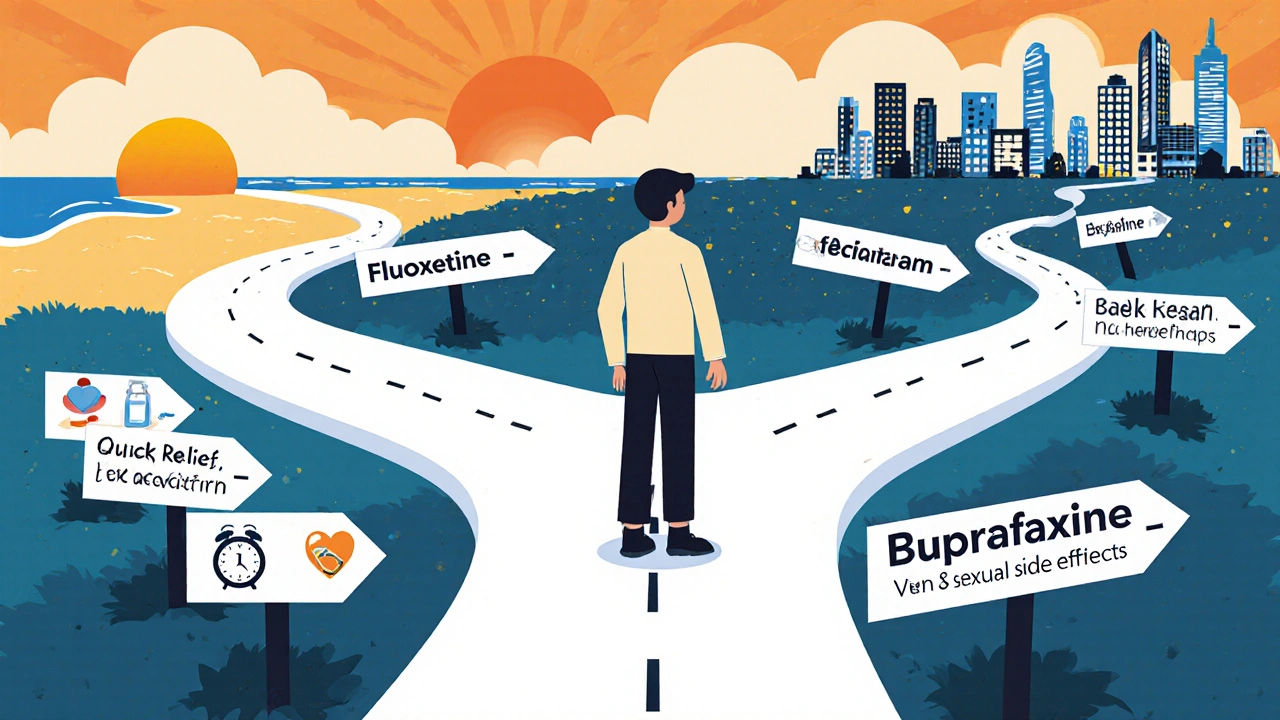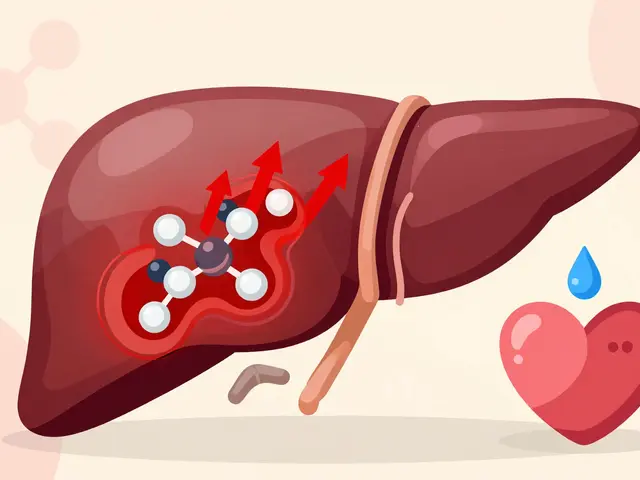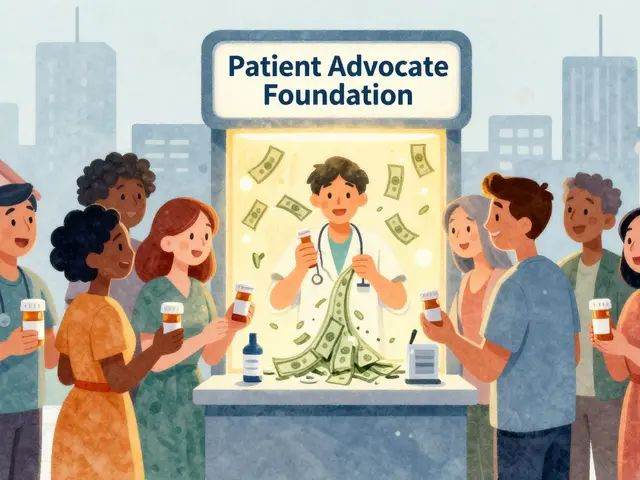
Antidepressant Decision Assistant
Find Your Best Match
This tool helps you compare fluoxetine and common alternatives based on your specific symptoms, medical history, and lifestyle factors. Select the options that best match your situation to get personalized recommendations.
Ever wondered whether the fluoxetine you’ve heard about is really the best choice for your mood issues? You’re not alone. Millions of people face the same question when a doctor mentions an SSRI, and the answer isn’t always straightforward. This guide breaks down fluoxetine, pits it against the most common alternatives, and gives you a clear roadmap to decide which pill might fit your life best.
What Is Fluoxetine?
Fluoxetine is a selective serotonin reuptake inhibitor (SSRI) prescribed for major depressive disorder, obsessive‑compulsive disorder, bulimia nervosa, and panic disorder. First marketed in the late 1980s under the brand name Prozac, it quickly became the poster child for modern antidepressant therapy.
How Fluoxetine Works
Fluoxetine blocks the serotonin transporter protein, keeping more serotonin in the synaptic gap. This boost in serotonin signaling is thought to improve mood, reduce anxiety, and help regulate appetite. Its mechanism is shared with other SSRIs, but its long half‑life (about 4‑6 days) sets it apart, providing a more stable blood level and a lower risk of abrupt withdrawal symptoms.
When Doctors Prescribe Fluoxetine
- Major depressive disorder (MDD)
- Obsessive‑compulsive disorder (OCD)
- Bulimia nervosa
- Panic disorder
- Premenstrual dysphoric disorder (PMDD)
Because it stays in the system for weeks after the last dose, fluoxetine is often the go‑to for patients who struggle with missing a day or two of medication.

Key Attributes of Fluoxetine
| Attribute | Detail |
|---|---|
| Generic Name | Fluoxetine |
| Brand Names | Prozac, Sarafem |
| Class | Selective serotonin reuptake inhibitor (SSRI) |
| Half‑life | 4-6 days (active metabolite 7-15 days) |
| Typical Starting Dose | 20 mg once daily |
| Common Side Effects | Nausea, insomnia, sexual dysfunction, dry mouth |
| Approx. Monthly Cost (US) | $15-$30 (generic) |
Top Alternatives to Fluoxetine
Below are the most frequently compared SSRIs and a few non‑SSRI options that often appear in a doctor’s toolbox.
- Sertraline - another SSRI known for a slightly shorter half‑life and broader anxiety coverage.
- Citalopram - praised for its simple dosing but carries a dose‑related QT prolongation risk.
- Paroxetine - a more sedating SSRI often chosen for patients with comorbid anxiety.
- Escitalopram - the S‑enantiomer of citalopram, marketed for its lower side‑effect profile.
- Venlafaxine - a serotonin‑norepinephrine reuptake inhibitor (SNRI) that can help when SSRIs fall short.
- Bupropion - a norepinephrine‑dopamine reuptake inhibitor (NDRI) that avoids sexual side effects.
Side‑by‑Side Comparison Table
| Drug | Class | Half‑life (days) | Typical Starting Dose | Key Advantages | Notable Drawbacks |
|---|---|---|---|---|---|
| Fluoxetine | SSRI | 4-6 (active metabolite 7-15) | 20 mg daily | Long half‑life reduces withdrawal risk; effective for bulimia | Potential for insomnia, activation |
| Sertraline | SSRI | ~26 hours | 50 mg daily | Strong anxiety relief; lower sexual side‑effects than fluoxetine | May cause diarrhea, tremor |
| Citalopram | SSRI | 35 hours | 20 mg daily | Simple dosing; mild side‑effect profile | QT interval prolongation at >40 mg |
| Paroxetine | SSRI | 21 hours | 20 mg daily | Highly sedating, good for insomnia | Weight gain, strong withdrawal symptoms |
| Escitalopram | SSRI | 27-32 hours | 10 mg daily | Highest efficacy among SSRIs; fewer side effects | Cost can be higher (brand) |
| Venlafaxine | SNRI | 5 hours (active metabolite 11 hours) | 75 mg daily | Effective for pain & anxiety; works when SSRIs fail | Blood pressure rise at high doses |
| Bupropion | NDRI | 21 hours | 150 mg daily | No sexual dysfunction; helps with smoking cessation | Risk of seizures at high doses |

Pros and Cons: Fluoxetine vs Each Alternative
Fluoxetine vs Sertraline
Both are SSRIs, but sertraline’s shorter half‑life means it reaches steady state faster, which can be good for quick symptom relief. Fluoxetine’s longer half‑life, however, makes missed doses less risky. If insomnia is a problem, sertraline often feels less activating.
Fluoxetine vs Citalopram
Citalopram is praised for a smoother start and fewer gastrointestinal complaints. Yet, its dosage ceiling (40 mg) limits use in severe depression, while fluoxetine can be titrated up to 80 mg without losing efficacy.
Fluoxetine vs Paroxetine
Paroxetine’s sedating effect helps patients with sleep disturbances, but it also brings a higher chance of weight gain and withdrawal headaches. Fluoxetine stays more energizing, which some patients prefer for daytime functioning.
Fluoxetine vs Escitalopram
Escitalopram often scores slightly higher on response rates in clinical trials, but the price tag can be steeper. Fluoxetine remains a cost‑effective first-line pick, especially for those with insurance coverage for generics.
Fluoxetine vs Venlafaxine
Venlafaxine adds norepinephrine reuptake inhibition, making it useful when anxiety or chronic pain co‑exists with depression. Its shorter half‑life demands strict adherence, and blood pressure must be monitored.
Fluoxetine vs Bupropion
Bupropion’s lack of sexual side effects makes it a favorite for younger adults. However, it doesn’t address the serotonin pathways, so it may be less effective for classic depressive symptoms compared to fluoxetine.
How to Choose the Right Medication
- Identify primary symptoms. If insomnia dominates, lean toward sertraline or paroxetine. If sexual dysfunction is a concern, consider bupropion or escitalopram.
- Check health history. Heart disease, seizure risk, or QT prolongation history will rule out certain drugs (e.g., high‑dose citalopram for cardiac patients).
- Consider lifestyle. Frequent travel or irregular schedules favor fluoxetine’s long half‑life; high‑pressure jobs may need the quicker onset of sertraline.
- Factor in cost and insurance. Generic fluoxetine and sertraline are usually the cheapest; brand‑only options like escitalopram may need prior authorization.
- Plan for side‑effect management. Start low, go slow, and schedule follow‑up visits to tweak dosage or switch drugs if intolerable effects arise.
Always discuss these points with a prescriber; the final decision should balance clinical evidence with your personal preferences.
Frequently Asked Questions
Can I switch from fluoxetine to another SSRI without a washout period?
Because fluoxetine stays in the body for weeks, most clinicians advise a gradual taper rather than an abrupt stop when moving to a different SSRI. A short overlapping period (often 1-2 weeks) can smooth the transition and limit withdrawal symptoms.
Is fluoxetine safe during pregnancy?
Fluoxetine is classified as Pregnancy Category C. Some studies link it to a slight increase in neonatal adaptation syndrome, but the risk of untreated maternal depression often outweighs medication concerns. Discuss benefits and risks with your obstetrician.
Why does fluoxetine cause insomnia for some people?
Fluoxetine’s activating effect on serotonin can increase alertness, especially at higher doses or when taken later in the day. Switching to a morning schedule or trying a less activating SSRI like sertraline often helps.
How long does it take for fluoxetine to start working?
Patients typically notice mood improvement after 2‑4 weeks, but full therapeutic effect may require 6‑8 weeks because of the drug’s long half‑life and gradual receptor changes.
Are there any dietary restrictions while on fluoxetine?
Avoid excessive alcohol, as it can increase sedation and liver stress. Grapefruit juice does not significantly affect fluoxetine metabolism, but always check with your pharmacist before adding new supplements.






6 Comments
I've seen many people struggle with picking the right antidepressant, and fluoxetine often tops the list because of its long half‑life. That steady level can be a blessing if you occasionally miss a dose, but it also means side effects linger. It's especially useful for bulimia and OCD where consistency matters. If insomnia is a problem for you, timing the dose in the morning can help. Always discuss these nuances with your prescriber.
Fluoxetine works well but sertraline might be easier on the stomach.
Most guides glorify fluoxetine as the safe choice, yet its activating properties can aggravate anxiety for many. The long half‑life sounds convenient, but it also delays withdrawal detection, masking poor tolerance. Consider a shorter‑acting SSRI if you want quicker feedback.
That's a fair point about the activation; I've heard colleagues suggest taking it early in the day to mitigate nighttime restlessness.
When weighing cost versus benefit, generic fluoxetine is hard to beat, especially when insurance coverage is limited. However, if sexual dysfunction is a dealbreaker, bupropion or escitalopram could be worth the extra expense. Keep an eye on how your body reacts in the first few weeks-sometimes side effects ease with time. A collaborative conversation with your doctor can tailor the plan to your lifestyle.
Fluoxetine, brand name Prozac, occupies a seminal position in psychopharmacology, yet its purported superiority warrants rigorous scrutiny. The drug’s pharmacokinetic profile is distinguished by an extended elimination half‑life, ranging from four to six days for the parent compound and up to fifteen days for its active metabolite, norfluoxetine. This protracted clearance confers a diminution of abrupt discontinuation phenomena, which is advantageous for patients prone to non‑adherence. Conversely, the same kinetic inertia may obscure early adverse reactions, delaying clinical recognition of intolerability. Epidemiological data indicate that fluoxetine demonstrates comparable efficacy to other selective serotonin reuptake inhibitors in ameliorating major depressive disorder, with remission rates approximating fifty percent in controlled trials. Moreover, its utility extends to bulimia nervosa, wherein serotonergic modulation attenuates impulsive binge‑purge cycles. Nonetheless, the activation syndrome-characterized by insomnia, agitation, and occasional heightened anxiety-remains a salient concern, particularly at dosages exceeding forty milligrams per day. Comparative analyses reveal that sertraline, possessing a markedly shorter half‑life of roughly twenty‑six hours, often yields more rapid therapeutic onset but necessitates vigilant dosing adherence. Citalopram, while lauded for tolerability, imposes a dose‑dependent QT interval prolongation risk that mandates electrocardiographic monitoring above twenty milligrams. Paroxetine’s pronounced anticholinergic activity predisposes patients to weight gain and severe withdrawal symptoms, limiting its desirability for long‑term maintenance. Escitalopram, the S‑enantiomer of citalopram, offers modestly superior efficacy with a reduced side‑effect burden, yet its cost may be prohibitive in uninsured cohorts. Venlafaxine, a serotonin‑norepinephrine reuptake inhibitor, expands the therapeutic armamentarium for comorbid anxiety and neuropathic pain but demands regular blood pressure surveillance. Bupropion, targeting dopaminergic and noradrenergic pathways, circumvents serotonergic sexual dysfunction but carries a seizure threshold consideration at elevated dosages. In summation, fluoxetine’s long half‑life and favorable cost profile render it a viable first‑line agent, yet individualized treatment selection should integrate symptomatology, side‑effect tolerance, pharmacogenomic factors, and socioeconomic constraints.